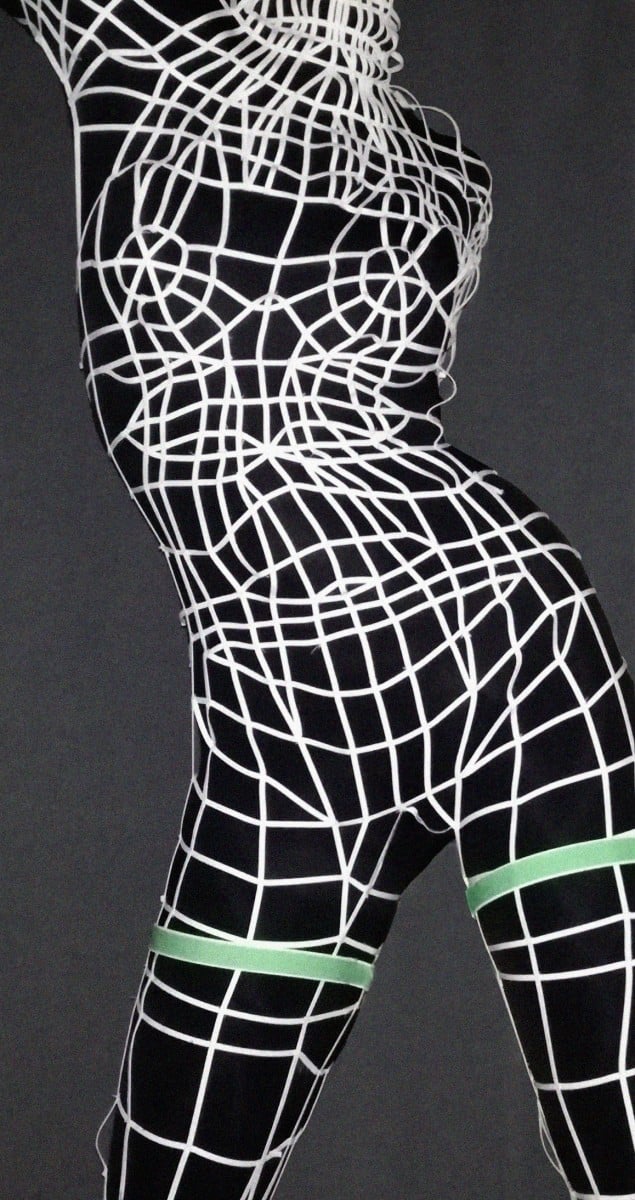
In her collection Deep Web Flora Miranda opens the debate on the concept of beauty in a technology-driven fashion industry. The collection can be seen this week at the Haute Couture Show in Paris in Le Grand Rex.
Flora Miranda works on the cutting edge of fashion and art and in creative networks. With recurring references to the digital world, she makes a connection to technological culture and aesthetics – a relatively new art movement. The movement is as elusive as the future possibilities of fashion, which she explores in her work.
In search of new techniques
Her way of working is that of a fashion designer. She develops seasonal collections around specific themes. Her mission, however, is not to make clothes that are suitable for everyday situations. Instead, she wants to explore the limits of haute couture, which is still based on traditional methods.
An example of this is her Master Collection, in which she researched quantum physics and teleportation and visualized how a body can be constructed from information and dissolved into separate parts to be transferred from a to b. In order to achieve the desired effects in material dynamics and statics, she is fully experimenting with everything that is at her disposal. In her research, a body consists of strips of painted leather combined. In this way, she searches for new techniques – independent of design tradition and history.
Beauty stereotypes
In her latest collection Deep Web, she deals with the production of clothing by artificial intelligence. She designs a system that she wants to use in the future and simulates it. The body model that Flora Miranda gives the learning computer is that of the American transgender artist Amanda Lepore, whose appearance pushes contemporary female beauty stereotypes to the limit.
The models in her collection reproduce this exaggerated femininity and reflect the strict categorization that technology prescribes – as well as the mechanical way in which subtle sex variations are treated. The mechanical creation process gives the clothing the appearance of a prefabricated product for an anonymous consumer.
Machinal fashion production
The artist sketches an image of digital transience and critically approaches artificial intelligence and the mathematical segmentation and categorization of the world. The questions she asks relate to the influence of machine production on future body images and ideals of beauty. To what extent are the organic ideals of beauty lost in the mechanical structure? The production of fashion by intelligent machines is inevitable and Flora Miranda uses the processing of these questions to reconsider and innovate fashion.
Smartphone Dress
In the presentation of her collection, Deep Web internet artist Signe Pierce wore a dress made of ten smartphones – produced in collaboration with Motorola. The ten devices make video recordings from different perspectives. During the first presentation, earlier this week, a live stream was shown on the facade of the EP7 Gallery in Paris. The gallery is a digital façade consisting of twelve monumental LED screens – and one of the first infrastructures dedicated to digital art in public space. With her keynote presentation, Flora Miranda wanted to stimulate a debate on the concept of beauty in a technology-driven fashion industry.
About Flora Miranda
The 28-year-old was born in a Salzburg (Austria) family of artists and holds a master’s degree in fashion from the Royal Academy of Fine Arts in Antwerp. After graduating in 2014, she collaborated with fashion designer Iris van Herpen in the Netherlands, who is best known for her 3D prints of polymers. Since November 2015 she has her own label in Antwerp. With her unique position Fora Miranda has already won a number of awards and her work has been shown in group exhibitions in museums. Recently she designed the costumes for the play Roughhouse in the Schauspielhaus Köln, performed by the American choreographer Richard Siegal.
